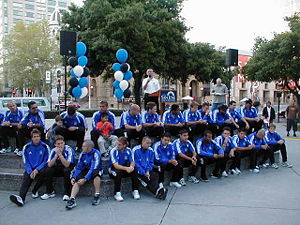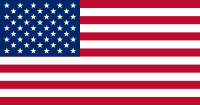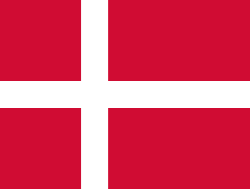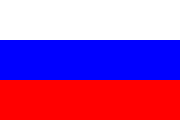San Jose Earthquakes
| Full name | San Jose Earthquakes | ||||||||||||||||||||||||||
|---|---|---|---|---|---|---|---|---|---|---|---|---|---|---|---|---|---|---|---|---|---|---|---|---|---|---|---|
| Nickname(s) | Earthquakes, Quakes, The Boys in Blue, Los Terremotos de San José |
||||||||||||||||||||||||||
| Founded | April 17, 1995 (as San Jose Clash) | ||||||||||||||||||||||||||
| Stadium | Buck Shaw Stadium[1] Santa Clara, CA (Capacity: 10,300) Oakland-Alameda County Coliseum[2] Oakland, CA (Capacity: 47,416) |
||||||||||||||||||||||||||
| Owner | |||||||||||||||||||||||||||
| Coach | |||||||||||||||||||||||||||
| League | Major League Soccer | ||||||||||||||||||||||||||
| 2008 | Western Conference: 7th Overall: 14th Playoffs: DNQ |
||||||||||||||||||||||||||
| First game | D.C. United 0 - 1 San Jose Clash (Spartan Stadium; April 6, 1996) |
||||||||||||||||||||||||||
| Largest win | 6–1 (2) 5–0 (1) |
||||||||||||||||||||||||||
| Largest defeat | 4-0 (2) 5-1 (1) |
||||||||||||||||||||||||||
| All-time top scorer | |||||||||||||||||||||||||||
| Supporters groups | Soccer Silicon Valley, The Casbah, Club Quake, 1906 Ultras |
||||||||||||||||||||||||||
| Honors | MLS Cup (2) Supporters' Shield (1) |
||||||||||||||||||||||||||
|
|||||||||||||||||||||||||||
The San Jose Earthquakes professional soccer team is located in San Jose, California and participates in the top level soccer league in the United States, Major League Soccer (MLS). The Earthquakes participated in MLS from 1995 to 2005, and resumed operations in 2007.[3] It is one of the original ten teams in the league, known as the San Jose Clash from 1995 to 1999. The Earthquakes defeated D.C. United 1–0 in the first game in MLS history. It is one of three teams from California to play in the league.
The team won the MLS Cup in 2001 and 2003, as well as the MLS Supporters' Shield in 2005. Following the 2005 MLS season in December of that year, the franchise was put on hiatus. The players and head coach Dominic Kinnear moved to Houston, Texas where they play as the Houston Dynamo. On July 18, 2007 it was announced that the San Jose Earthquakes would resume play starting in the 2008 season.[4] The Earthquakes play most home games at Buck Shaw Stadium in Santa Clara, California.
History
Roots of the Earthquakes
- For more information see San Jose Earthquakes (NASL) and San Francisco Bay Blackhawks.
The franchise's roots trace back to 1974, when the North American Soccer League (NASL) awarded an expansion franchise to San Jose, named the Earthquakes. The NASL folded after the 1984 season, and the Earthquakes played in the Western Soccer League (WSL) from 1985–88, under the ownership of Peter Bridgwater.
In 1988, Bridgwater sold the team. When the team folded later that year, the WSL awarded a franchise to Dan Van Voorhis, a local real estate lawyer. Van Voorhis named his new team the Blackhawks, after a real estate development of his. The San Francisco Bay Blackhawks entered the WSL for the 1989 season. In 1991, Van Voorhis hired a former Earthquakes' player, Laurie Calloway, as coach. Calloway coached a team full of players that would later play for San Jose in MLS, including John Doyle, Troy Dayak, Paul Bravo and Eric Wynalda. In a preview of what was to come later in MLS, bitter disagreements between Calloway and Wynalda led to Calloway kicking Wynalda off the team in 1992. Blackhawks owner Dan Van Voorhis later pulled his team out of the WSL's successor league, the American Professional Soccer League, after which they played as the San Jose Hawks in the USISL in 1993. The team folded at the end of the 1993 season.
Major League Soccer

In 1994, Van Voorhis successfully led a San Jose bidding group which was awarded one of Major League Soccer's inaugural teams. At that time, he handed over all existing Hawks player contracts, front-office resources and the rights to play in Spartan Stadium to MLS in exchange for Type C stock in the league. He also became the franchise's investor/operator until outside concerns forced him to divest himself of these positions prior to the league's launch and accept a buyout from the league, leaving the franchise league-owned for several years. Meanwhile, a direct connection to the earlier Earthquakes came in the person of Peter Bridgwater, named as General Manager of the MLS team. Although Bridgwater, at the time, still owned the rights to the Earthquakes' name and logo, the team became known as the Clash at the urging of Nike, a major investor in MLS.
On December 7, 1995, Bridgwater hired Calloway as the team's first coach, providing a second direct connection with the NASL Earthquakes, as well as a connection with the Blackhawks. Ignoring the past history between Calloway and Wynalda with the Blackhawks, the team acquired Wynalda just over a month later, on January 23, 1996. The Clash's connections to the Blackhawks continued when the Clash made the first trade in MLS history, sending Rhett Harty to the MetroStars for Troy Dayak, both players having spent several years with the team. Despite the presence of Calloway and much of his former team, the Clash failed to achieve the dominance achieved by the Blackhawks.
Wynalda scored the first goal in MLS history. However, he and Calloway were soon at each other's throats. The tensions on the team led eventually led to a locker room brawl between Wynalda and John Doyle. On top of that was an infamous incident in which Wynalda hired an aircraft towing a banner demanding the Clash fire Calloway.[5]
Although the Clash made the postseason in the inaugural 1996 MLS season, and Doyle earned recognition as the best MLS defender, the team floundered in 1997. By the middle of the 1997 season, the team was sinking fast and Bridgwater fired Calloway, to be replaced by Brian Quinn. The Clash finished 1997 with a 12–20 and at the bottom of the Western Conference standings. In 1998 things got no better as the team finished 13–19 and well out of playoff contention. During the 1999 pre-season, the saga of player-coach antagonism continued when Richard Gough left the team after an argument with Quinn. By the end of 1999, Quinn was done and the team released him to hire Lothar Osiander.
Return of the Earthquakes name
The franchise's official name changed from Clash to Earthquakes on October 27, 1999.

After missing four consecutive post-seasons with three different coaches, the Earthquakes hired head coach Frank Yallop days before the 2001 MLS SuperDraft. Yallop's personnel changes and deft coaching with the help of assistant coach Dominic Kinnear and goalkeeper coach Tim Hanley, along with the allocation of star forward Landon Donovan on loan from Bayer Leverkusen, quickly turned around the Earthquakes' on-field fortunes, spurring the biggest regular season turnaround in league history (from 29 points in 2000 to 45 points in 2001) and leading the team to a 2–1 MLS Cup 2001 overtime victory over the arch rival Los Angeles Galaxy.
The Quakes followed with two consecutive runners-up finishes for the MLS Supporters' Shield and a 4–2 MLS Cup 2003 win over the Chicago Fire. Prior to reaching the 2003 final, the Earthquakes had rallied from four goals down to beat the Galaxy, 5–4 on aggregate, in a first-round playoff that many MLS observers described as the greatest in MLS history. Following the season, Yallop returned to his native Canada to coach the Canadian men's national soccer team. Assistant coach Kinnear was then promoted as the team's next head coach, and former San Jose player John Doyle was named as his assistant.
Having won two MLS Cup titles in three years, the Earthquakes were poised for greater success both on and off the field. However, in January 2004, General Manager Johnny Moore, whose roots with the club dated back to his days as a player for the NASL Earthquakes, resigned after AEG and MLS considered allowing the team to be rebranded as "San Jose America" (with ownership to transfer to the owners of Mexico's Club America). Earthquake fans were similarly outraged at the proposed rebranding, coming just months after the MLS Cup. Former Los Angeles Galaxy defender Alexi Lalas was named as his replacement. Under Lalas' management, the club planned a move to Houston. Meanwhile, when the Quakes' star player, Landon Donovan, played briefly in Germany while Lalas traded away his rights, thus allowing Lalas' former team, the Galaxy, to acquire him.
On the field, Kinnear led the team to two more playoff appearances, including a MLS Supporters' Shield win in 2005.
Move to Houston
The owner of the San Jose Earthquakes, Anschutz Entertainment Group, announced on December 15, 2005 that the team was moving to Houston for the 2006 season due to the failure of securing a new soccer-specific stadium for the team in San Jose. The franchise was renamed to Houston 1836, then to Houston Dynamo. However, MLS Commissioner Don Garber said that the Earthquakes' name, colors, logo, wordmark, history and competitive records would not be transferred, similarly to the Cleveland Browns deal in the National Football League. The Houston Dynamo is technically considered an expansion team by MLS just as the Baltimore Ravens is by the NFL.
Return of the Earthquakes
On May 24, 2006, an agreement was reached between Major League Soccer and the principal owners of the Oakland Athletics baseball team. Lewis Wolff and John Fisher have a three year exclusive option to develop a soccer-specific stadium and bring an expansion franchise to the San Francisco Bay Area.[6]
In September 2006, after nearly nine months of inactivity (displaying only Commissioner Garber's December 2005 letter of condolence to Earthquakes fans over the team's relocation), the team's website was revived to display updates on the progress of starting up the expansion San Jose Earthquakes franchise and to allow fans to sign up for the Earthquakes Soccer, LLC e-newsletter.
On July 18, 2007, Commissioner Don Garber announced, at his annual state of the league address, that the San Jose Earthquakes will resume play starting in the 2008 season after Lew Wolff exercised his option to purchase the new expansion team. The expansion team however retains all records, logos, colors and titles of the 1996–2005 franchise and is in essence a continuation of that franchise, while functionally being the 14th franchise to join MLS.
In October 2007 the Earthquakes announced they would be moving their offices from the Fairmont Hotel in downtown San Jose to an office park across the street from their temporary home, Buck Shaw Stadium, and across the Caltrain tracks from the location of the FMC site.[7]
On November 6, 2007, the team announced that former Earthquakes coach Frank Yallop was returning to the team as head coach. According to ESPN.com, the Earthquakes compensated Yallop's previous employer, the Los Angeles Galaxy, with a third-round pick in the 2008 MLS SuperDraft.[8]
Logo
Partnerships and Affiliations
Tottenham Hotspur F.C.
At a joint press conference on October 9, 2008, the Earthquakes and Tottenham Hotspur F.C. announced a strategic partnership between the two clubs.[9] The partnership involves both business and soccer interests including, but not limited to, sharing marketing ideas, training facilities and playing friendlies against each other. The deal aims to grow each team's soccer interests and respective brands on both sides of the Atlantic.
New stadium
On January 13, 2007, the San Jose Mercury News reported that the city of San Jose, San Jose State University and the Earthquakes owners were in negotiations to build a 22,000 permanent seat (with the option to increase the total capacity to 30,000 seats for any given game) soccer/football stadium just east of the Earthquakes' previous home of Spartan Stadium. The new facility would be privately built by Lewis Wolff and John Fisher, the primary owners of the Earthquakes, with San Jose State providing the needed land. Additionally, the team and the university would build community soccer fields across Senter Road in Kelley Park using still-unspent San Jose municipal bond money approved years earlier for such community soccer fields.[10] The plan was for the new version of the San Jose Earthquakes to play in Spartan Stadium during the 2008 MLS season, then to move into the new stadium in 2009. Plans for the stadium collapsed on April 19 of that year after the Earthquakes and SJSU could not come to an agreement on revenue sharing for the stadium.
On May 8, the city of San Jose and Earthquakes Soccer, LLC confirmed that their new primary focus was on a site near San Jose International Airport on the site of the former FMC plant. The new site is owned by the city, which is exploring either leasing it to Earthquakes Soccer, LLC or selling it outright. The 75-acre site is adjacent to not only the airport but the planned BART extension to Santa Clara and the existing Santa Clara Caltrain station in addition to being in proximity to both Interstate 880 and U.S. Route 101. On June 12, 2007, the San Jose City Council voted unanimously to enter into a Memorandum of Understanding to explore construction of a new stadium to bring MLS back to San Jose and adopted a resolution authorizing the city manager to enter into an Exclusive Right to Negotiate agreement with Wolff and his partners regarding the potential development of the FMC site. The preliminary designs have yet to be released to the public. The first payment on the new stadium land of $3 million dollars was made the last week of June 2008.
The team currently plays its smaller attendance games at Buck Shaw Stadium in Santa Clara and its larger attendance games at the Oakland-Alameda County Coliseum in Oakland, and will continue to do so until the completion of a new soccer specific stadium in San Jose which is scheduled to open between 2010 and 2011.[11][12]
Television and radio
Earthquakes games are televised locally on CSN Bay Area and CSN California, with John Shrader providing the play-by-play, Troy Dayak providing the color analysis and Kate Longworth providing reports from the sideline.[13]
A number of games are instead televised nationally on ESPN2/ESPN2HD/ESPN Deportes, Fox Soccer Channel/Fox Sports en Español, HDNet and TeleFutura.
On radio, all Earthquakes games are broadcast in Spanish on KLOK-AM.
Official Anthem
The San Jose Earthquakes Anthem is performed by Bay Area rapper E-40.
Domestic Honors
League
- MLS Cup:
- Winners (2): 2001, 2003
- MLS Supporters' Shield:
- Winners (1): 2005
- Runners-up (2): 2002, 2003
Invitational
- Carolina Challenge Cup (pre-season):
- Winners (2): 2005, 2008
Rivalries
- The team's main historic and geographic rival is the Los Angeles Galaxy. From 1996 to 2005, they competed each season in the California Clasico, which was put on hold following the 2005 MLS season. The California Clasico was resumed in 2008.
- A growing rivalry is also forming with the Houston Dynamo. The Dynamo was created from the players and coach that made up the Earthquakes franchise prior to 2005 when they were moved from San Jose to Houston. The rivalry was further stoked via comments made in the Houston media about the Earthquakes and their fans.
- The Heritage Cup derby with the Seattle Sounders FC is set to begin in the 2009 MLS season. It will be contested among the MLS teams (present and future) that carry on the names of their NASL predecessors.[14][15][16]
Team management
- General Manager:
 John Doyle
John Doyle - Head Coach:
 Frank Yallop
Frank Yallop - Assistant Coach:
 Ian Russell
Ian Russell - Goalkeeper Coach:
 Jason Batty
Jason Batty - Technical Advisor:
 Ronnie Ekelund
Ronnie Ekelund - Athletic Trainer:
 Bruce Morgan
Bruce Morgan - Equipment Manager:
 Jose Vega
Jose Vega - Team Administrator:
 Joe Dincecco
Joe Dincecco
Players
Current Roster
As of November 26, 2008. [17]
|
|
Notable former players
This list of former players includes those who received international caps while playing for the team, made significant contributions to the team in terms of appearances or goals while playing for the team, or who made significant contributions to the sport either before they played for the team, or after they left. It is clearly not yet complete and all inclusive, and additions and refinements will continue to be made over time.
|
|
Team captains
 John Doyle (1996-2000)
John Doyle (1996-2000) Jeff Agoos (2001-2004)
Jeff Agoos (2001-2004) Wade Barrett (2005)
Wade Barrett (2005) Nick Garcia (2008- )
Nick Garcia (2008- )
San Jose Earthquakes Hall of Fame
 John Doyle (inducted 2005)
John Doyle (inducted 2005)
Head coaches
 Laurie Calloway (1996-1997)
Laurie Calloway (1996-1997) Brian Quinn (1997-1999)
Brian Quinn (1997-1999) Jorge Espinoza (1999) (interim)
Jorge Espinoza (1999) (interim) Lothar Osiander (1999-2000)
Lothar Osiander (1999-2000) Frank Yallop (2001-2003)
Frank Yallop (2001-2003) Dominic Kinnear (2004-2005)
Dominic Kinnear (2004-2005) Frank Yallop (2008- )
Frank Yallop (2008- )
Team records
- Games: Richard Mulrooney, 163
- Goals: Ronald Cerritos, 61
- Assists: Ronald Cerritos, 47
- Shutouts: Pat Onstad, 27
Home stadiums
- Spartan Stadium (1996-2005)
- Buck Shaw Stadium (2008- )
- Oakland-Alameda County Coliseum (2008- ) (big game venue)[18]
- Earthquakes Stadium (2010/2011 planned)
General Managers
 Peter Bridgwater (1995-1998)
Peter Bridgwater (1995-1998) Lynne Meterparel (1999-2000)
Lynne Meterparel (1999-2000) Tom Neale (2001)
Tom Neale (2001) Johnny Moore (2002-2003)
Johnny Moore (2002-2003) Alexi Lalas (2004-2005)
Alexi Lalas (2004-2005) Kate McAllister (2005; interim)
Kate McAllister (2005; interim) Ken Freccero (2005; interim)
Ken Freccero (2005; interim) John Doyle (2008- )
John Doyle (2008- )
Ownership
- Major League Soccer (1996-1998)
- Kraft Sports Group (1999-2000)
- Silicon Valley Sports & Entertainment (2001)
- Silicon Valley Sports & Entertainment (Operations) / Anschutz Entertainment Group (Investment) (2002)
- Anschutz Entertainment Group (2003-2005)
- Earthquakes Soccer, LLC (2007- )
Mascots
- José Clash (1996-1999)
- Rikter the CyberDog (2000-2002)
- Q (2004-2005, 2008- )
Year-by-year
| Year | Reg. Season | Playoffs | Open Cup | CONCACAF Champions' Cup |
SuperLiga | |||||
|---|---|---|---|---|---|---|---|---|---|---|
| San Jose Clash | ||||||||||
| 1996 | 4th, West | Quarterfinals | Did not enter | Did not qualify | Started in 2007 | |||||
| 1997 | 5th, West | Did not qualify | Quarterfinals | Did not qualify | ||||||
| 1998 | 5th, West | Did not qualify | Quarterfinals | Did not qualify | ||||||
| 1999 | 5th, West | Did not qualify | Did not enter | Did not qualify | ||||||
| San Jose Earthquakes | ||||||||||
| 2000 | 4th, West | Did not qualify | Quarterfinals | Did not qualify | Started in 2007 | |||||
| 2001 | 2nd, West | Champions | Quarterfinals | Not held | ||||||
| 2002 | 2nd, West | Quarterfinals | Quarterfinals | Quarterfinals | ||||||
| 2003 | 1st, West | Champions | Round of 16 | First Round | ||||||
| 2004 | 4th, West | Quarterfinals | Semifinals | Quarterfinals | ||||||
| 2005 | 1st, West* | Quarterfinals | Quarterfinals | Did not qualify | ||||||
| 2006 | On Hiatus | |||||||||
| 2007 | ||||||||||
| 2008 | 7th, West | Did not qualify | Did not qualify | Did not qualify | Did not qualify | |||||
* Won MLS Supporters' Shield
International competition
- 2002 CONCACAF Champions' Cup
- First Round v.
 CD Olimpia -- 1:0, 3:1 (Earthquakes advance 4:1 on aggregate)
CD Olimpia -- 1:0, 3:1 (Earthquakes advance 4:1 on aggregate) - Quarterfinals v.
 CF Pachuca -- 0:3, 1:0 (Pachuca advances 3:1 on aggregate)
CF Pachuca -- 0:3, 1:0 (Pachuca advances 3:1 on aggregate)
- First Round v.
- 2003 La Manga Cup
- Group Stage v.
 Rosenborg BK -- 0:2
Rosenborg BK -- 0:2 - Group Stage v.
 Rubin Kazan -- 1:1
Rubin Kazan -- 1:1 - Group Stage v.
 Viking -- 1:3
Viking -- 1:3 - Seventh Place Match v.
 Lyn Oslo -- 3:1
Lyn Oslo -- 3:1
- Group Stage v.
- 2003 CONCACAF Champions' Cup
- First Round v.
 CSD Municipal -- 2:4, 2:1 (Municipal advances 5:4 on aggregate)
CSD Municipal -- 2:4, 2:1 (Municipal advances 5:4 on aggregate)
- First Round v.
- 2004 La Manga Cup
- Group Stage v.
 GIF Sundsvall -- 3:1
GIF Sundsvall -- 3:1 - Group Stage v.
 Stabæk -- 2:1
Stabæk -- 2:1 - Semifinals v.
 Viking -- 1:1 (Viking Stavanger advances 5:3 on penalties)
Viking -- 1:1 (Viking Stavanger advances 5:3 on penalties) - Third Place Match v.
 Dynamo Kyiv -- 1:1 (Earthquakes win 6:5 on penalties)
Dynamo Kyiv -- 1:1 (Earthquakes win 6:5 on penalties)
- Group Stage v.
- 2004 CONCACAF Champions' Cup
- Quarterfinals v.
 LD Alajuelense -- 0:3, 1:0 (Alajuelense advances 3:1 on aggregate)
LD Alajuelense -- 0:3, 1:0 (Alajuelense advances 3:1 on aggregate)
- Quarterfinals v.
Average attendance
regular season / playoffs
- 1996: 17,232 / 17,209
- 1997: 13,597 / missed playoffs
- 1998: 13,653 / missed playoffs
- 1999: 14,959 / missed playoffs
- 2000: 12,460 / missed playoffs
- 2001: 9,635 / 13,269
- 2002: 11,150 / 8,069
- 2003: 10,465 / 15,127
- 2004: 13,001 / 8,659
- 2005: 13,037 / 17,824
- 2006: On hiatus
- 2007: On hiatus
- 2008: 13,713 / missed playoffs
- All-Time: 12,991 / 13,569
See also
- San Jose Earthquakes (NASL)
- 2007 MLS Expansion Draft
Notes
- ↑ The Official Site of Earthquakes Soccer, LLC - News
- ↑ Big-game venue
- ↑ SI.com - Writers - Jonah Freedman: Quakes are back - and here's what it means for MLS - Tuesday July 17, 2007 4:31PM
- ↑ MLS press release
- ↑ CNNSI.com - Soccer - MLS - Soccer America: Quakes fans due for some luck - Wednesday March 21, 2001 02:51 PM
- ↑ Jordan, Robertson, Oakland A's owners to bring pro soccer back to Bay area, http://www.sfgate.com/cgi-bin/article.cgi?f=/news/archive/2006/05/24/state/n100047D92.DTL, retrieved on 2007-11-08
- ↑ Witt, Barry, Quakes move closer to Buck Shaw, http://www.mercurynews.com/search/ci_7168688?nclick_check=1, retrieved on 2007-11-08
- ↑ Carlisle, Jeff, Galaxy's Yallop resigns to coach Quakes, http://soccernet.espn.go.com/news/story?id=479078&cc=5901, retrieved on 2007-11-08
- ↑ San Jose Earthquakes Media Relations, San Jose Earthquakes Establish Strategic Partnership with Premier League's Tottenham Hotspur Football Club, http://www.mlsnet.com//news/team_news.jsp?ymd=20081009&content_id=194643&vkey=pr_sje&fext=.jsp&team=t110, retrieved on 2008-10-09
- ↑ Wilner, Jon, Stadium deal builds at SJSU, http://www.mercurynews.com/mld/mercurynews/16452867.htm, retrieved on 2007-11-08
- ↑ Molina, Joshua, San Jose soccer stadium closer to reality, http://geeklinks.vox.com/library/post/san-jose-soccer-stadium-closer-to-reality.html, retrieved on 2008-4-15
- ↑ Silicon Valley / San Jose Business Journal, $132M deal worked out for San Jose pro soccer stadium, http://www.bizjournals.com/sanjose/stories/2008/04/14/daily20.html, retrieved on 2008-4-15
- ↑ Comcast SportsNet Bay Area, Earthquakes broadcasters, http://bayarea.comcastsportsnet.com/Bios_Earthquakes.jsp
- ↑ Clark, Dave, To DP, or not to DP, http://sounderatheart.com/2008/09/to-dp-or-not-to-dp/, retrieved on 2008-10-31
- ↑ Emerald City Supporters forum, NASL Heritage Cup, http://www.weareecs.com/phpBB/viewtopic.php?t=1122, retrieved on 2008-10-31
- ↑ Gagliardi, Don, (SQR) San Francisco Examiner: Freddie Ljungberg goes Emerald as Seattle soccer fans cheer (BigSoccer.com forums), http://www.bigsoccer.com/forum/showpost.php?p=16141050&postcount=15, retrieved on 2008-10-31
- ↑ http://web.mlsnet.com/players/roster.jsp?club=t110
- ↑ San Jose Earthquakes: Home: FAQ
External links
- www.sjearthquakes.com Team's official website
- www.1906ultras.com Supporters' Club website
- www.clubquake.org Supporters' Club website
- www.thecasbah.org Supporters' Club website
- www.bigsoccer.com BigSoccer's online community for Earthquakes fans
- www.SoccerSiliconValley.com Grassroots group working to help create a permanent home for the team
- www.CenterLineSoccer.com San Jose Earthquakes specific news website
|
|||||||||||||||||||||||||||||||||||||||||||||||
|
|||||||||||||||||||||||||||
|
|||||||||||||||||||||||